ASRock Z590 Taichi Review: An Intel Motherboard with Moving Parts (and Thunderbolt 4)
by Gavin Bonshor on April 1, 2021 11:00 AM ESTVisual Inspection
The overall design of the Taichi series has followed a progressive trajectory over the last couple of years. Sitting now as one of ASRock's more premium models. the entire aesthetic has revolved around the use of cogwheels what the company itself dubs as the 'Philosophy of Infinite Potential'. For Z590, the Taichi moves to an all-black design, with a plain black PCB, black heatsinks, and primarily black PCIe slot armor. The Z590 Taichi has plenty of customizable RGB LED lighting, with four zones including two in the plastic rear panel cover, one area within the chipset heatsink, and along the right-hand side of the board which creates an under glow effect.
Dominating the lower section of the board is the PCIe slot area. The ASRock Z590 Taichi includes two full-length PCIe 4.0 slots that can operate at x16 and x8/x8, a third full-length slot electronically locked down to PCIe 3.0 x4, and a single PCIe 3.0 x1 slot. All three of the board's full-length slots include ASRock's Steel Slot reinforcement, with the PCIe armor blending in nicely with M.2 heatsinks. Touching on the storage, the Z590 Taichi includes one PCIe 4.0 x4 M.2 slot, and two PCIe 3.0 x4 M.2 slots that also support SATA. For SATA devices, ASRock includes a combined total of eight, with six powered by the chipset and two driven by an ASMedia ASM1061 SATA controller. As expected, the six SATA ports from the chipset support RAID 0, 1, 5, and 10 arrays. Below are the limitations on storage devices due to bandwidth sharing between slots/connectors:
- M2_2, SATA3_0, and SATA 3_1 share bandwidth, if one is used, it disables the other two
- M2_3, SATA3_4 and SATA3_5 and PCIE_4 share bandwidth. if one is used, it disables the other three
Along the bottom of the board towards the right-hand corner, there's a small overclockers toolkit which consists of a power button, a reset button, a two-digit LED debugger, and a small clear CMOS button. Around the board's edge is a total of eight 4-pin headers which include one for a CPU fan, one doubling up as a CPU fan and water pump header, and six for chassis fans. Other useful front panel headers include a single USB 3.2 G2x2 Type-C header, two USB 3.2 G1 Type-A headers (four ports), and two USB 2.0 headers (two ports).
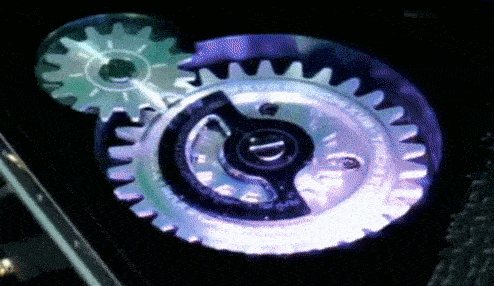
The moving cogwheel built into the Z590 Taichi rear panel cover.
One of the new and interesting things about the Z590 Taichi's new design is that it has implemented a mechanical cogwheel into the rear panel cover. This can spin both clockwise and anti-clockwise with a stepping motor providing power and rotation to the cog. Within the firmware, users can adjust the time interval between the rotations, including 5, 10, 30, and 60-minute intervals, or of course switch it off altogether.
In the top right-hand corner, there are four memory slots in total, which include support for up to DDR4-5000 out of the box. This also includes support for up to 128 GB, with official support for non-ECC memory modules only. As with all of Intel's Z590 models, memory kits with Intel XMP 2.0 memory profiles are support.
The ASRock Z590 Taichi is using a premium 14-phase power delivery operating in a 6+2 configuration. The CPU section includes twelve Renesas ISL99390 90 A SPS power stages with six Reneasas ISL6617A doublers. ASRock includes two ISL99390 90 A SPS power stages for the SoC section, with a Renesas ISL69269 PWM controller operating in 6+2 mode. In addition to this, each physical power stage includes 90 A alloy inductors, with a total of fourteen present. Overall, the Z590 Taichi can deliver up to 1080 A of current on the CPU side, with two 8-pin 12 V ATX CPU power inputs delivering the power. Using doublers is a conventional way of adding in more operating phases which can effectively reduce the overall temperature with the aim of increasing thermal efficiency, without sacrificing too much in the way of VDroop and overall power efficiency.
Cooling the power delivery is a large pair of heatsinks, which are interconnected via a large single heat pipe. Integrated into the CPU section is a small cooling fan, which makes the power delivery an actively cooled solution. ASRock includes a pair of brackets, one for a 3 cm fan without included in the bundle, as well as a 4 cm bracket for users wishing to add their own. This can be installed onto the end of the SoC area heatsink, with pre-installed mounting holes available to use.
At the back of the board, the Z590 Taichi includes a half-cover backplate, which adds extra thermal properties to the back of the power delivery, as well as extra rigidity across the board. It's black, includes some Taichi cogwheel design, primarily behind the chipset heatsink, although the likelihood of seeing this within a system is slim in a conventional chassis.
Looking at the onboard audio solution of the Z590 Taichi, ASRock is using a Realtek ALC1220 HD audio codec, with an assisting ESS Sabre 9218 DAC with an SNR of up to 130 dB, and supports headphones with an impedance of up to 600 ohms. Flanking the HD audio codec are three Japanese Gold Nichicon audio capacitors, with four WIMA audio capacitors located at the bottom. The audio PCB is separated from the rest of the board with a gold-colored separating line, which is designed to improve signal quality and reduce interference from the board's other electronic components.
On the rear panel is a good selection of input and output, including dual Thunderbolt 4 40 Gbps Type-C, which also provide support for compliant and compatible Thunderbolt monitors. What's interesting here though is that ASRock hasn't labeled these Type-C ports with the official TB4 logos. Other USB connectivity includes two USB 3.2 G2 Type-A, and four USB 3.2 G1 Type-A ports. For audio, there are five 3.5 mm audio jacks and S/PDIF optical output located in the center of the rear panel, which is all powered by a Realtek ALC1220 HD audio codec and ESS Sabre 9218 DAC pairing, with one HDMI 2.0 video output providing access to Intel's UHD integrated graphics. On the networking side of things, ASRock includes two RJ45 ports, one driven by a Killer E3100G 2.5 GbE and the other by an Intel I219-V Gigabit controller, with a Killer AX1675x Wi-Fi 6E CNVi. Finishing off the rear panel is a BIOS Flashback button.
The two USB 3.2 G1 Type-A ports located between the HDMI 2.0 and audio connectors, are what ASRock likes to call its 'Lightning Gaming Ports'. One port is designated for a keyboard and another for a mouse. ASRock says this is patent-pending, and what makes it unique is one that runs from a separate USB controller, an ASMedia ASM1042A. ASRock claims this to improve jitter latency, by reducing the amount of traffic across the USB controller.
What's in The Box
Included with the ASRock Z590 Taichi is a pretty comprehensive accessories bundle that features everything needed to get a system running out of the box. The package consists of an installation manual, three black SATA cables, two M.2 screw installation kits, as well as two Killer antenna AX1675x Wi-Fi 6E CNVi. One of the interesting additions is a USB 2.0 to 2 x Type-A header which allows users to add two USB 2.0 ports to the rear panel. This is something I haven't seen included with a motherboard for a long time.
Also included in the accessories bundle is ASRock's patent-pending Graphics Card Holder. Designed to ease the burden and help eliminate sag on heavy graphics cards, this is supplied with ASRock's more mid-range and premium options. It has a sliding mechanism for easy installation, and all of the screws come supplied as well as mounting holes on the board.
- Quick installation guide
- Software installation guide
- ASRock Taichi sticker sheet
- ASRock Taichi postcard
- 2 x Killer AX1675x antenna
- ASRock Torx screwdriver
- 2 x M.2 installation screw kits
- 2 x ASRock velcro cable ties
- USB 2.0 to 2 x Type-A expansion card
- 3 x SATA 6 Gbps cables (black)
- ASRock 3 cm VRM fan and bracket kit
- ASRock GPU Holder


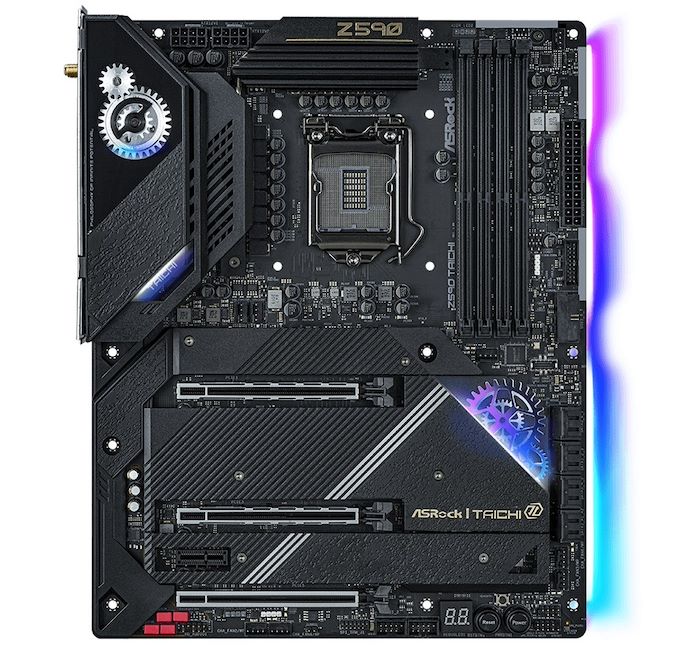

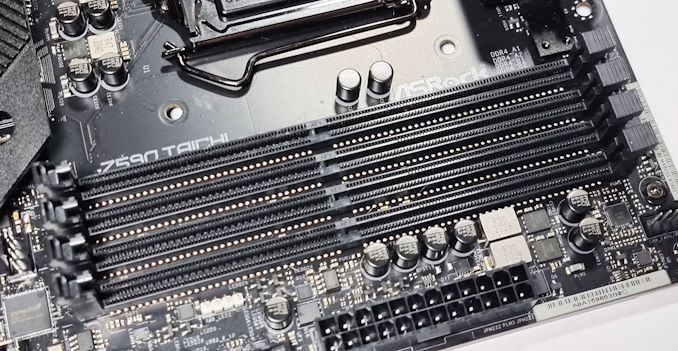
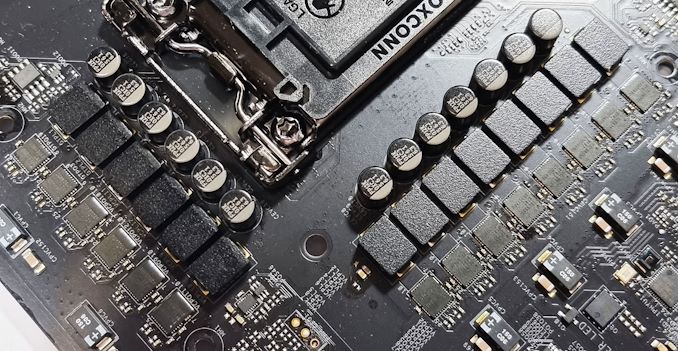
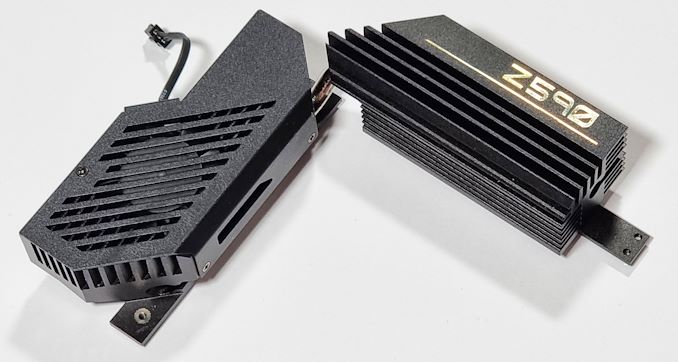
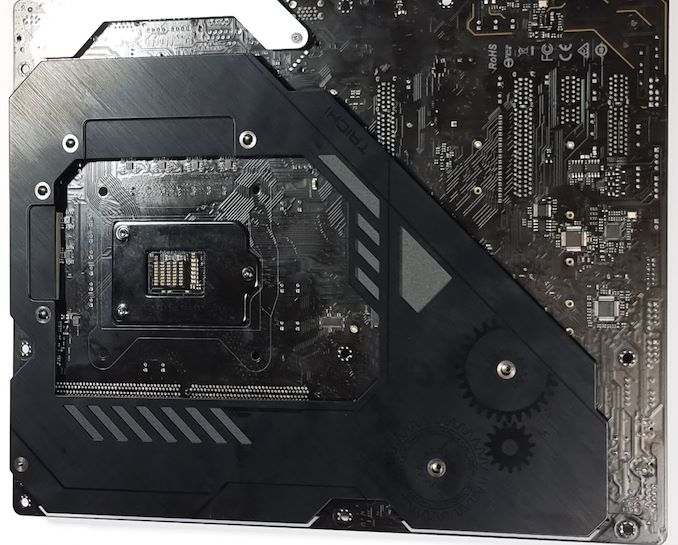
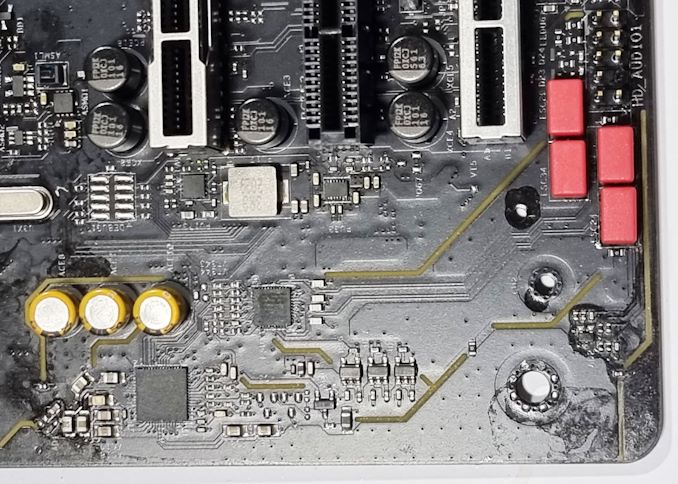

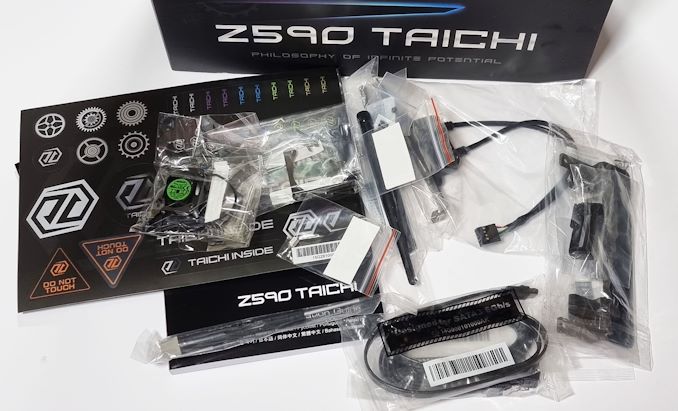
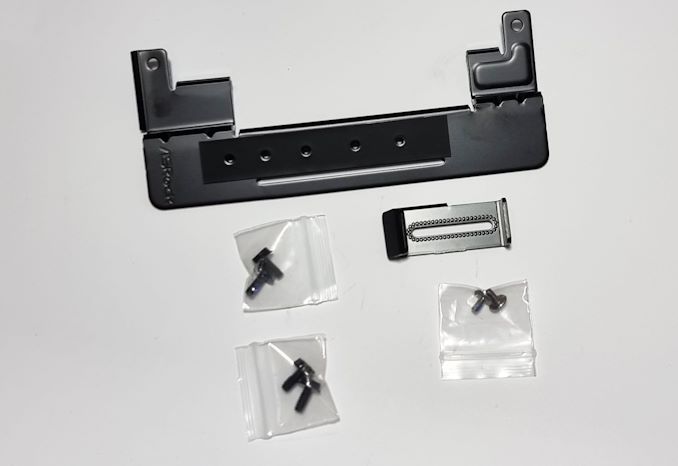








50 Comments
View All Comments
Cullinaire - Thursday, April 1, 2021 - link
What a gimmick. Instead of a stepper motor why not have a steam engine powered by the CPU heat.Molor1880 - Thursday, April 1, 2021 - link
Should have gone with a tiny sterling engine. That would make this joke a bit better.kachan64 - Friday, April 2, 2021 - link
Agree. Should have gone with that!YB1064 - Friday, April 2, 2021 - link
No 10GbE on a FOUR HUNDRED dollar motherboard?? No thanks.zanon - Saturday, April 3, 2021 - link
This, the money they put into the gimmick useless juno should have gone to networking instead. Though I suppose in fairness unlike AMD they have to work with severe bandwidth limitations so they can't just do every single useful feature. But that one should have been a priority.ZoZo - Saturday, April 3, 2021 - link
There's the same bandwidth on the Z590 platform as the X570.20 PCI-E 4.0 lanes from the CPU, and ~4 GB/s between CPU and chipset (through 4 PCI-E 4.0 lanes on X570, and 8 DMI/PCI-E 3.0 lanes on Z590).
And 10 Gb/s networking just needs 1.25 GB/s, so no severe bandwidth limitations from connecting it to a PCI-E 3.0 x1 link to the chipset.
TheinsanegamerN - Sunday, April 4, 2021 - link
The raichu line had 10gb as a selling point with the z200 and x400 vhipsets. For some reason asrock abandoned this idea and raised the price.TheinsanegamerN - Sunday, April 4, 2021 - link
Agreed. The whole reason to get a taichi was the 10gb ethernet onboard.Samus - Saturday, April 3, 2021 - link
This is about the level of gimmick I expected from ASRock, after all the brand is a second-rate Asus so they need to do these cheesy things to get attention.zotric - Sunday, October 10, 2021 - link
I must say I have had excellent support for my older ASRock Taichi board so don't write it off!